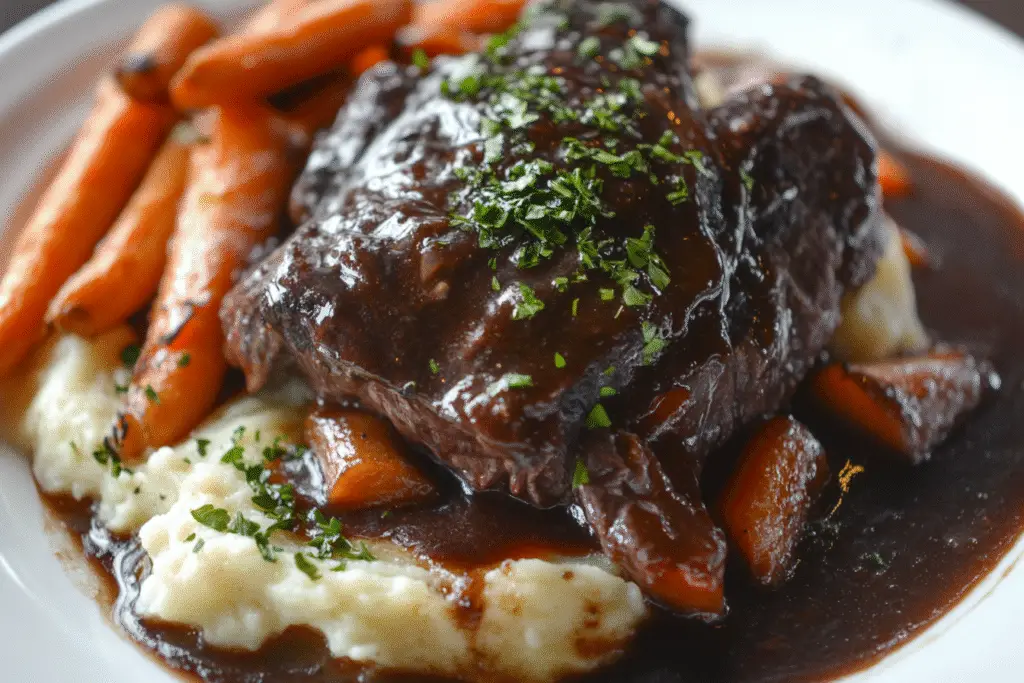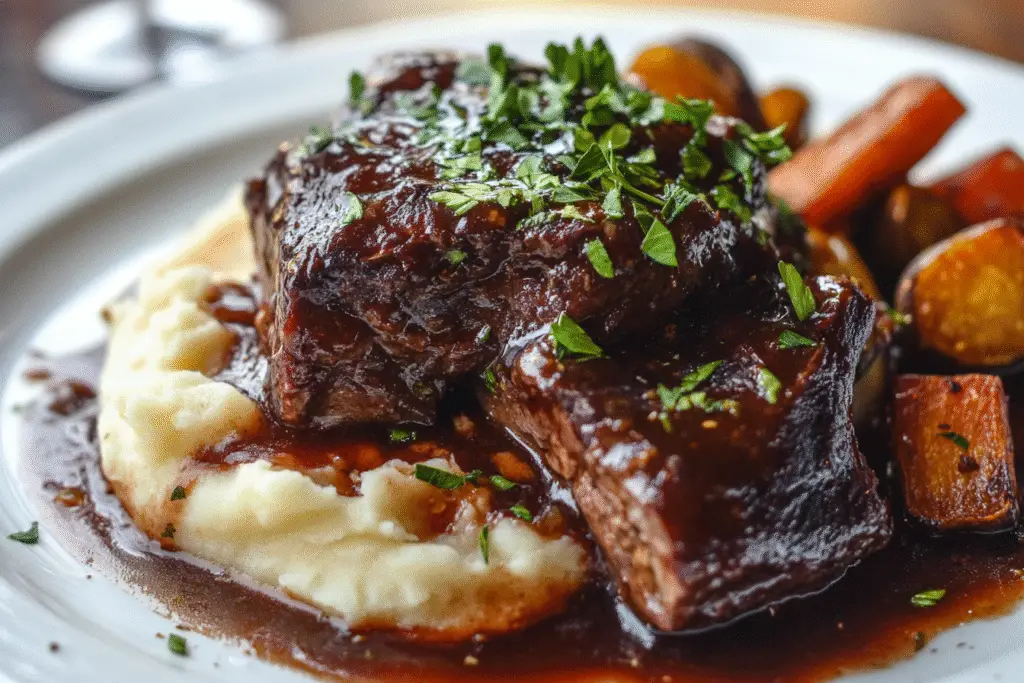Beef cheeks are an incredibly tender, collagen-rich cut that, when cooked properly, yield melt-in-your-mouth results with deep, savory flavor. Long overlooked, beef cheeks have gained popularity among home cooks and chefs alike for their luxurious texture, bold beefiness, and ability to absorb complex flavors during slow cooking.
Whether you’re making them for a cozy dinner, an impressive weekend meal, or a special occasion, this step-by-step Beef Cheeks Recipe will guide you through choosing the right ingredients, braising techniques, and common troubleshooting tips to help you prepare a restaurant-quality dish in your own kitchen.
Why Beef Cheeks Can Be Challenging: Common Mistakes and How to Avoid Them
Beef cheeks are a specialty cut that can be a little tricky if you’re not familiar with their unique qualities. Common pitfalls include:
- Chewy or tough texture: Happens when the beef hasn’t cooked long enough to break down the connective tissue.
- Overly greasy sauce: Occurs if excess fat is not properly trimmed or skimmed.
- Bland flavor: Caused by under-seasoning or rushing the browning step.
- Thin, watery sauce: Often the result of not reducing the braising liquid enough.
How to Ensure Perfect Beef Cheeks:
- Low and slow cooking is non-negotiable—plan for 3-4 hours of braising.
- Trim excess fat and silver skin before cooking.
- Brown the beef thoroughly to build deep flavor.
- Simmer uncovered at the end to reduce the sauce to a velvety consistency.

Selecting the Best Ingredients for Braised Beef Cheeks
Beef Cheeks
- Ask your butcher: Beef cheeks can be a specialty item but are increasingly available in well-stocked butcher shops and some grocery stores.
- Look for: Firm, well-trimmed beef cheeks with some marbling but minimal excess fat.
- Tip: Each cheek typically weighs 8-12 ounces and serves one person.
Aromatics and Vegetables
- Base: Onions, carrots, celery, and garlic build the flavor foundation.
- Herbs: Fresh thyme, rosemary, bay leaves, and parsley stems add depth.
Braising Liquid
- Red wine: Traditional for rich flavor, but beef broth alone works for a non-alcoholic version.
- Beef broth: Complements and strengthens the beefy flavor.
- Tomato paste: Adds acidity and body to the sauce.
Essential Equipment
- Heavy-bottomed Dutch oven or braiser: Retains heat evenly for long, gentle cooking.
- Tongs: For safely turning beef cheeks during searing.
- Fine mesh strainer: Useful for creating a smooth sauce if desired.
If you don’t have a Dutch oven, a deep ovenproof pot with a tight-fitting lid works well.

Smart Preparation Tips
Preparation Timeline:
- Active cooking: 30 minutes
- Braising: 3-4 hours
Make-Ahead Tips:
- Beef cheeks taste even better the next day as flavors develop.
- You can braise the beef cheeks, cool completely, and reheat before serving.
- The sauce can be made ahead and stored separately if you want to skim fat more thoroughly.
Flavor Variations and Customizations
- Wine-Based Sauce: Classic pairing for beef cheeks. Use a full-bodied red like Cabernet Sauvignon or Shiraz.
- Beer Braise: Use a dark stout for a richer, slightly bitter edge.
- Asian-Style: Swap herbs for star anise, ginger, soy sauce, and add a splash of rice vinegar.
Side Dishes:
- Serve with creamy mashed potatoes, polenta, or pappardelle pasta to soak up the sauce.
- Add roasted root vegetables or a crisp green salad for balance.
Common Mistakes and How to Fix Them
- Tough Beef Cheeks: They need more time. If they’re still chewy after the recommended cooking time, simply continue simmering until tender.
- Sauce Too Thin: Remove the beef cheeks and simmer the sauce uncovered until thickened.
- Sauce Too Greasy: Skim fat from the top, or refrigerate and remove solidified fat before reheating.
- Flat Flavor: Ensure proper seasoning throughout and fully brown the beef and vegetables at the beginning.
Storage, Freezing, and Reheating Tips
- Storage: Keep in an airtight container in the fridge for up to 4 days. Flavors improve over time.
- Freezing: Beef cheeks freeze well. Cool completely, then freeze in sauce for up to 3 months.
- Reheating: Warm gently on the stovetop or in a 325°F (165°C) oven until heated through. Add a splash of broth if needed.
Braised Beef Cheeks Recipe
Ingredients
For the Beef:
- 4 beef cheeks (about 2½–3 pounds total), trimmed
- Salt and black pepper, to taste
- 2 tablespoons olive oil
For the Braise:
- 1 large onion, diced
- 2 large carrots, diced
- 2 celery stalks, diced
- 4 cloves garlic, minced
- 2 tablespoons tomato paste
- 2 cups dry red wine
- 2 cups beef broth
- 4 sprigs fresh thyme
- 2 sprigs fresh rosemary
- 2 bay leaves
For Garnish:
- Fresh parsley, chopped
Step-by-Step Instructions
Step 1: Prepare the Beef Cheeks
- Season beef cheeks generously with salt and black pepper.
- Heat olive oil in a Dutch oven over medium-high heat.
- Sear beef cheeks for 3-4 minutes per side until well-browned. Remove and set aside.
Step 2: Build the Braise
- In the same pot, sauté onions, carrots, and celery for 5-7 minutes until softened.
- Add garlic and tomato paste; cook for 2 minutes until fragrant.
- Deglaze with red wine, scraping up browned bits.
- Simmer for 3-5 minutes to reduce slightly.
Step 3: Add Liquids and Herbs
- Return beef cheeks to the pot.
- Add beef broth, thyme, rosemary, and bay leaves.
- The beef should be mostly submerged—add extra broth or water if needed.
- Bring to a gentle simmer.
Step 4: Braise Low and Slow
- Cover and transfer to a 325°F (165°C) oven.
- Braise for 3-4 hours, turning beef cheeks halfway through.
- Check for doneness: beef cheeks should be fork-tender and easily shred.
Step 5: Reduce the Sauce
- Remove beef cheeks and keep warm.
- Strain sauce if desired for a smooth consistency.
- Simmer sauce on the stovetop until thickened to a velvety texture.
- Taste and adjust seasoning.
Step 6: Serve
- Plate beef cheeks over mashed potatoes, polenta, or pasta.
- Spoon sauce generously over the top.
- Garnish with fresh parsley.
Serving Suggestions
- Classic: Serve over creamy mashed potatoes with roasted root vegetables.
- With Pasta: Pair with pappardelle or tagliatelle.
- With Polenta: Soft, buttery polenta beautifully absorbs the rich sauce.
- With Sides: Try a fresh arugula salad, crusty bread, or roasted Brussels sprouts.
Beef Cheeks Variations: Wine vs. Beer vs. Asian-Style
| Feature | Red Wine Braise | Beer Braise | Asian-Style Braise |
|---|---|---|---|
| Flavor Profile | Rich, classic, savory | Deep, malty, slightly bitter | Savory, sweet, aromatic |
| Cooking Liquid | Red wine and beef broth | Dark stout or porter | Soy sauce, ginger, star anise |
| Common Sides | Potatoes, pasta, polenta | Mashed potatoes, root vegetables | Rice, sautéed greens |
FAQs and Troubleshooting
Can I use a slow cooker?
Yes. After browning the beef and sautéing the vegetables, transfer to a slow cooker and cook on low for 8-9 hours.
Can I make this in a pressure cooker?
Yes. Cook on high pressure for about 45-60 minutes. Natural release preferred.
Why are my beef cheeks still tough?
They simply need more time. Continue braising until they’re fork-tender.
Can I use a different cut?
Yes. Short ribs or chuck roast are great alternatives.
Can I make it without wine?
Absolutely. Use extra beef broth and a splash of balsamic vinegar for acidity.
Final Thoughts
Beef cheeks are a hidden gem in the world of slow-cooked dishes, offering unparalleled tenderness, deep flavor, and an almost luxurious mouthfeel when cooked correctly. While they require patience and care, the reward is a dish that feels both rustic and refined—perfect for special dinners or anytime you want to create a meal that’s comforting yet impressive.
With this step-by-step Beef Cheeks Recipe, you’ll learn to braise like a pro, master the timing, and balance flavors to create restaurant-quality results at home. Serve them with your favorite sides and enjoy every melt-in-your-mouth bite.
